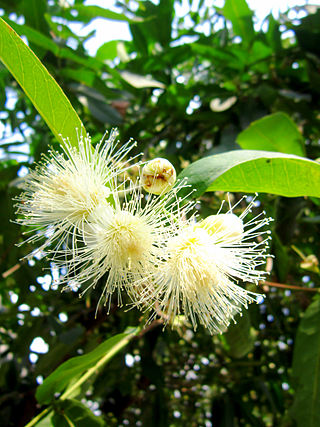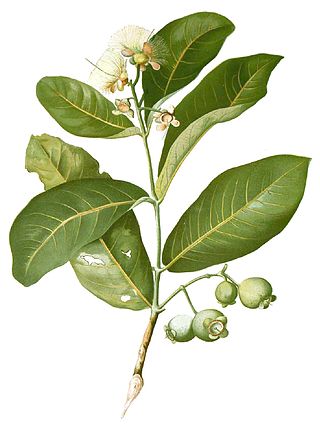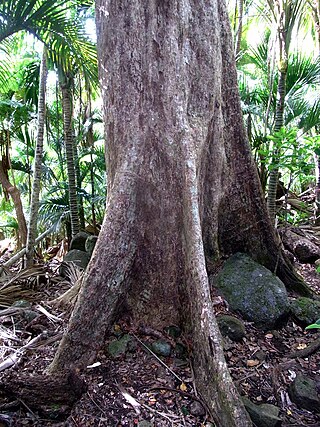
Syzygium samarangense is a species of flowering plant in the family Myrtaceae, native to an area that includes the Greater Sunda Islands, Malay Peninsula, and the Andaman and Nicobar Islands, but introduced in prehistoric times to a wider area and now widely cultivated in the tropics. Common names in English include wax apple, Java apple, Semarang rose-apple, and wax jambu.

Syzygium is a genus of flowering plants that belongs to the myrtle family, Myrtaceae. The genus comprises about 1200 species, and has a native range that extends from Africa and Madagascar through southern Asia east through the Pacific. Its highest levels of diversity occur from Malaysia to northeastern Australia, where many species are very poorly known and many more have not been described taxonomically. One indication of this diversity is in leaf size, ranging from as little as a half inch to as great as 4 ft 11 inches by sixteen inches in Syzygium acre of New Caledonia.

Syzygium cumini, commonly known as Malabar plum, Java plum, black plum, jamun, jaman, jambul, or jambolan, is an evergreen tropical tree in the flowering plant family Myrtaceae, and favored for its fruit, timber, and ornamental value. It is native to the Indian subcontinent and Southeast Asia. It can reach heights of up to 30 m (100 ft) and can live more than 100 years. A rapidly growing plant, it is considered an invasive species in many world regions.

Syzygium paniculatum, the magenta lilly pilly or magenta cherry, is a species of flowering plant in the myrtle family Myrtaceae, native to New South Wales, Australia. A broad dense bushy rainforest tree, in cultivation it grows to a height of 15 m (49 ft) with a trunk diameter up to 35 cm (14 in). The largest known example is at Ourimbah Creek, 35 m (115 ft) metres tall. The leaves are 3–9 cm (1.2–3.5 in) long, opposite, simple and slightly obovate, tapering at the leaf base. They are dark glossy green above, and paler below. White flowers are produced in clusters. The edible fruit is usually magenta, but can be white, pink or purple. The seeds are polyembryonic.

Syzygium malaccense is a species of flowering tree native to tropical Asia and Australia. It is one of the species cultivated since prehistoric times by the Austronesian peoples. They were carried and introduced deliberately to Remote Oceania as canoe plants. In modern times, it has been introduced throughout the tropics, including many Caribbean countries and territories.
Syzygium courtallense is a species of plant in the family Myrtaceae. It is tree that grows in the wet tropical biomes of southwest India and Sri Lanka. It is threatened by habitat loss.

Syzygium densiflorum is a species of evergreen tree in the family Myrtaceae. It is endemic to the Western Ghats mountains, India. The species is categorised as Vulnerable in the IUCN Red List.

Syzygium aqueum is a species of brush cherry tree. Its common names include watery rose apple, water apple and bell fruit, and jambu in Malay and several Indian languages.

Syzygium australe, with many common names that include brush cherry, scrub cherry, creek lilly-pilly, creek satinash, and watergum, is a rainforest tree native to eastern Australia. It can attain a height of up to 35 m with a trunk diameter of 60 cm. In cultivation, this species is usually a small to medium-sized tree with a maximum height of only 18m.

Syzygium guineense is an evergreen leafy forest tree of the family Myrtaceae, found in many parts of Africa both wild and domesticated. Both its fruits and leaves are edible; the pulp and the fruit skin are sucked and the seed discarded. It is sometimes called "waterberry", but this may also refer to other species of Syzygium.

Syzygium papyraceum, known as the paperbark satinash, is a rainforest tree of northeastern Queensland, Australia. It can grow to 35 m (115 ft) tall and 90 cm (35 in) in diameter, with papery red-brown bark. Leaves are simple, arranged in opposite pairs, and measure up to 10 cm (3.9 in) long and 5 cm (2.0 in) wide. Attractive pink or mauve flowers are followed by purple fruit. It was first described in 1983 by the Australian botanist Bernard Hyland.

Syzygium cormiflorum, commonly known as the bumpy satinash, is a species of Syzygium tree endemic to Queensland in northeastern Australia.

Syzygium fullagarii, commonly known as the scalybark, is a relatively large tree in the family Myrtaceae. It is found only on Lord Howe Island. It grows to 20 metres tall, up to an altitude of 400 metres above sea level in sheltered areas, often in rainforest. The bark is reddish brown, usually flaking to the touch. The base of the tree is often heavily buttressed. Known for many years as Cleistocalyx fullagarii, however, in recent times it has been placed in the large genus Syzygium.

Syzygium alliiligneum, commonly known as onionwood, Mission Beach satinash or bark in the wood is a species of plant in the family Myrtaceae. It is endemic to a small part of north eastern Queensland.

Syzygium forte, commonly known as flaky-barked satinash, white apple or brown satinash, is a tree in the family Myrtaceae native to New Guinea and northern Australia.

Syzygium canicortex, commonly known as yellow satinash, is a tree in the family Myrtaceae native to Queensland, Australia, first described in 1983.

Syzygium zeylanicum, the spicate eugenia, is a species of flowering plant in the family Myrtaceae. It is widely distributed, from Madagascar and India to China, Southeast Asia, and Malesia. A shrubby tree typically reaching 12 m (39 ft), it prefers coastal secondary forests, forest edges, and riverbanks.

Syzygium racemosum, the wax jambu, is a species of flowering plant in the family Myrtaceae. It is native to Thailand, Peninsular Malaysia, Java, the Lesser Sunda Islands, and Borneo. A tree reaching 37 m (120 ft), it is occasionally harvested for its timber, and a black dye can be made from its bark.

Syzygium buxifolium, the boxleaf eugenia or fish-scale bush, is a species of flowering plant in the family Myrtaceae, native to northern Vietnam, southern China, Hainan, Taiwan, the Ryukyu Islands, and southern Kyushu, Japan. A shrub or small tree, it is suitable for hedges, containers, and bonsai. It is used as a street tree in a number of southern Chinese cities.

Syzygium curranii, commonly known as lipote, is a species of tree endemic to the Philippines. It bears sweet to sour black or red berries that can be eaten fresh, but are more commonly turned into jams or wine. The tree grows to a height of around 15 m (49 ft). The leaves are oblong in shape and are around 20 to 25 cm long and 6 to 8 cm wide. The tree is also harvested for its timber which is used for construction. It is not commercially cultivated and the fruit is harvested from the wild. It is threatened with habitat loss.



















